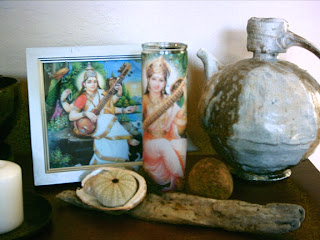Saraswati, the goddess of arts, music,
wisdom and knowledge. I used this as inspiration to create a singing bowl meditation.
Singing Bowl Meditation, The
Prana of Sound by Kevin Tracy
Clang, clang, clang - Tapping on the side of the bowl with a wooden striker to produce a sharp bell like tone.
This is just one sound of the bowl. Mystery surrounds the
Tibetan singing bowl, its origins, its use. Is is ceremonial or purely decorative. When asked about its use monks would often reply "perhaps."
1
This
mystery invites interpretation to its use and function. Traditional singing bowls are made of seven metals: lead, tin, iron, copper, mercury, silver and gold.
1
The human body contains seven
chakras: muladhara,
svadhisthana,
manipura,
anahata,
vishudda,
anja,
sarashara.
2Each metal is directly linked to a
chakra.
2 Following this Yogic, the singing bowl can be thought of as a direct metaphor for the human body, "Clang". As we move up the
chakras we can think of turning lead into gold.
Healers have recognized this connection and use the singing bowls for sound therapy. Each
chakra has its one tone or pitch: C, D, E, F, G, A, B
respectively. Every bowl is hand-crafted, it is unique and will have its own sound. Sound is used to open the
chakras which heal sickness in the body.
As we become aware of this healing power, we begin to see how we "clang" through life and our
bodies. But is this music? Is this the way we are to use our sacred vessel? What did the monks know and not tell us?
When we start our day, perhaps the first "clang" is the sound of the alarm clock. We then roll over and hit the snooze button. Our second "clang," that cup of coffee or tea as
caffeine gives us a jolt to awaken the senses. We continue to "clang" throughout our daily lives.
Through yoga we become more aware of our selves and our mind/body connection through breath and meditation. Perhaps we did not even know that we were clanging through life. With yoga we begin to move differently. There is a shift, a whole new sound within our body.
(Begin to create the smooth tone by rolling the striker around the edge of the bowl.) One without an end or beginning, a rolling sound, a harmonious sound that is in concert with our body. Let this new sound resonate through you. Spend five minutes, inhale breath in the "
Prana of Sound." Fill your body with its life force. Create a
dialogue, exploring each chakra as the sound moves up through the
body with the smooth tone.
As we begin to move today, stay with the sound and "
evoke the yoke," the bowl/body connection. See what movements resonate within yourself. Bring the connection between the breath and body, through movement. Can we use the body, our sacred vessel, without "clanging" on it?
References: 1. Singing Bowls, Rudy Jansen and 2. The Walking Dream, Ray Grasse










